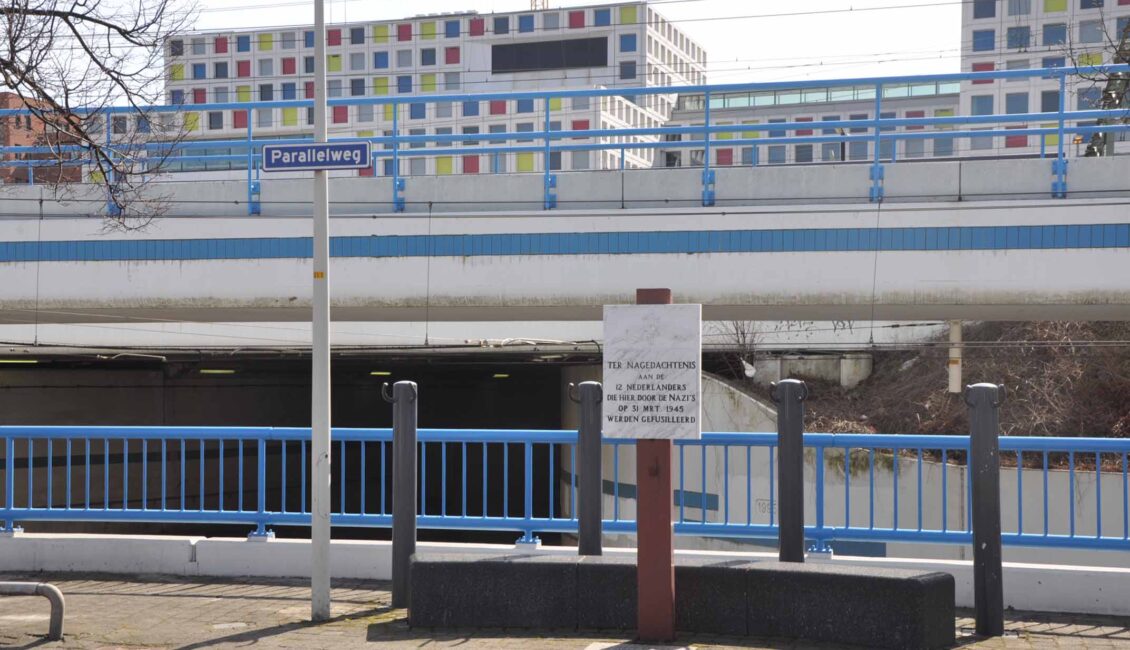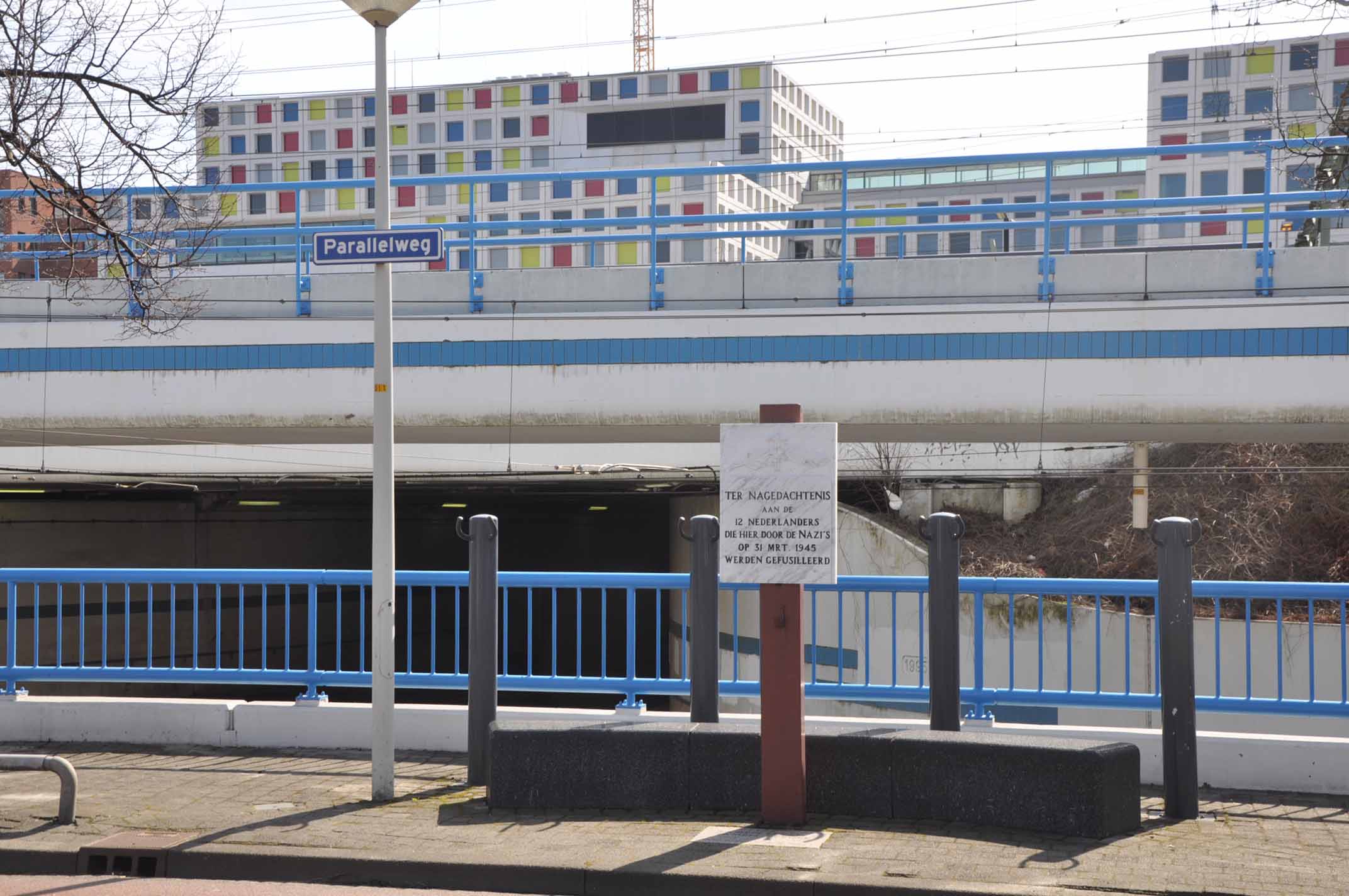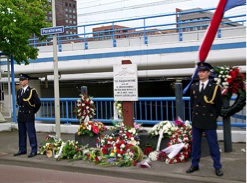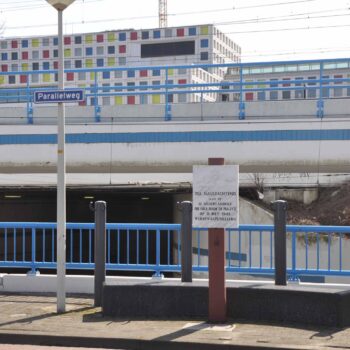
Monument Memorial Site Parallelweg
Designer: unknown
Unveiled on March 29, 1946
On the Parallelweg, at the Naaldwijksestraat, you will find the monument in memory of the twelve Dutch prisoners who were shot by the Germans at this location on 31 March 1945. This execution was one of the most public executions during the war in the Netherlands.

The monument consists of a wooden pole with a marble plaque on which a cross and a text are depicted. The pole is located in front of a fence that separates the Parallelweg from the tram track. The text on the plaque is as follows:
“In memory of the 12 Dutch people who were shot here by the Nazis on March 31, 1945.”
The execution on the Parallelweg
On 29 March 1945, during a resistance raid, two German soldiers were molested and disarmed on the Parallelweg. A day later, a column of Ordnungspolizei trucks was stopped by resistance fighters and thrown into confusion. These relatively minor acts of resistance went down badly with the Germans and a reprisal followed.
On March 31, 1945, twelve men were taken from the Scheveningen prison and brought to the Parallelweg. A large number of local residents were forced by the Germans to watch as these twelve men, in groups of four, were put against the fence and shot.
The execution of reprisals became an increasingly common part of the war violence from the summer of 1944 onwards. The man in charge of the reprisals in The Hague was the head of the Sicherheitspolizei J.H.L. Munt. Munt was seen as a moderate man, and he had a certain “sympathy” for resistance fighters, whom he saw as brave but misguided idealists. This sympathy ultimately saved several dozen lives of resistance fighters. Usually, resistance fighters were designated as Todeskandidaten for reprisals. However, Munt often did not supply resistance fighters but ordinary criminals.
Eleven of the twelve men who were executed on 31 March 1945 at the Parallelweg were supplied by Munt. One of these eleven may have been involved in the resistance, the other ten had already been arrested several times for robberies. In addition, two of them had deserted from the NSKK (Nationalsozialistische Kraftfahrkorps, a paramilitary unit of the NSDAP) and one was a member of the NSB and the defense department. The twelfth man was supplied by F. Frank, a brutal and fanatical man who was charged with combating espionage and resistance within the Sicherheitspolizei. Frank did supply a resistance fighter.
On 29 March 1946, the local residents, who had been forced to attend the executions a year earlier, together with relatives, held a modest and sober commemoration at the site of the executions. During this commemoration, they placed the first memorial plaque.
There has been a lot of involvement from local residents over the years. As a result, there is always representation from (migrant) residents’ organizations at the commemoration.
The Hague Municipal Archives conducted further research in early 2020 in response to questions from a family member of one of the victims. The question arose as to who is actually commemorated on the Parallelweg. An attempt was made to give the twelve men more faces and to find out more about their background. Among other things, the question was whether and to what extent they were involved in opposition or ‘resistance’ against the occupier, or had collaborated with them. The research describes the victims and their backgrounds and places the execution against the background of the last months of the war.
Read here Research of the Hague municipal archives into Parallelweg victims
https://www.stichtingnationaleherdenkingsgravenhage.nl/parallelweg-31-3-1945-def9712/

The Remembrance
Every year on May 4th a commemoration takes place at the memorial site on Parallelweg. At 19:50 the memorial procession leaves for the monument.
Sources:
Boom, Bart van der. The Hague in the Second World War. The Hague: SeaPress, 1995.
www.4en5mei.nl
